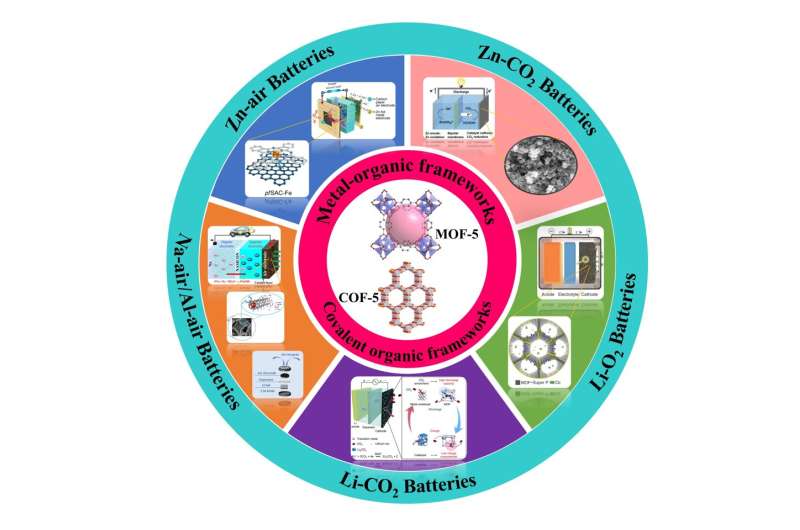This article has been reviewed according to Science X's editorial process and policies. Editors have highlighted the following attributes while ensuring the content's credibility:
fact-checked
proofread
Novel porous materials are ideal for metal-air batteries, researchers report

Sustainable energy solutions cannot be pulled out of thin air. However, combining air with metal and other frameworks may pave the way for environmentally friendly energy conversion and storage, according to a research team based in China.
They published their review of novel porous materials—called metal-organic frameworks (MOFs) and covalent organic frameworks (COFs)—and their potential to advance metal-air batteries in Nano Research Energy.
The porous crystal material frameworks comprise various arrangements of bonded materials that can induce desired properties, including the ability to accelerate reactions between oxygen and metals for energy conversion and storage. Their diverse arrangements facilitate flexibility, with high porosity and surface area, allowing for the best chance of the necessary reactions. Their derivates, or products derived from the frameworks, also enhance previously insufficient electronic conductivity and improve chemical stability.
But their advancement has been limited by inadequate conductivity and stability, according to co-corresponding author Tao Wang, professor, Centre for Hydrogenergy, College of Materials Science and Technology, Nanjing University of Aeronautics and Astronautics.
"Metal-air batteries, with high specific energy, moderate pricing, high safety and environmental friendliness, are the most promising candidate for energy storage and conversion," Wang said. "At present, however, metal-air batteries involve a complex catalytic process of gas-liquid-solid phases, making it difficult to deeply understand the mechanism of discharge and recharge processes."
Wang also noted that some of the MOF and COF arrangements have slow reaction kinetics, meaning an efficient catalyst is needed both to reduce potential conversion challenges and improve the battery's life cycle.
To better understand how to control benefits—and mitigate the challenges—of the frameworks and their derivates, the researchers reviewed the current available scientific literature. Among other insights, they found that the frameworks exhibit a unique molecular structure that enables high porosity with uniform distribution of catalytic sites, meaning their reactions can be more predictable than with other porous materials.
"By systematically studying the effects between organic components and catalytic active centers of MOFs and COFs, we can gain a theoretical basis for us to select and synthesize the desired framework catalysts in the future," Wang said. "We can also better understand the local microenvironment in MOFs and COFs and how it impacts the overall catalytic effect."
Wang and the team recommend further study of how to better prepare functionalized MOFs and COFs based on their reaction mechanism; of hybrid MOFs and COFs; and of the composition control and morphology of MOF and COF derivates. They also recommend developing more advanced techniques to detect the vibration signals of molecules on the electrode surface and observe the conversion process to fully elucidate the relationship between the structure and the performance.
"By comprehensively reviewing the advantages, challenges and prospects of MOFs and COFs, we hope that the organic framework materials will shed more profound insights into the development of electrocatalysis and energy storage in the future," Wang said.
More information: Yunyun Xu et al, Application of metal-organic frameworks, covalent organic frameworks and their derivates for the metal-air batteries, Nano Research Energy (2023). DOI: 10.26599/NRE.2023.9120052
Provided by Tsinghua University Press




















